Tuesday is Louisville’s mayoral primary. This is one of the issues that matter for the city’s future. 8664 has published the results of a candidate questionnaire on their web site. Also note that 8664 co-founder Tyler Allen is running for mayor. If I still lived in Louisville, it would be a sure thing he’d have my vote! – Aaron. ]
A few weeks ago, JC Stites, co-founder of 8664 invited me down to Louisville to talk about the proposal and take a first hand tour of the riverfront. Even as a Louisville native, I had never really walked around there, which shows you how disconnected the city is from the river. The experience is eye-opening. So I thought I’d share some of what I saw with you.
First, here’s a short 40 second video of JC talking about 8664 and what they hope to accomplish:
However, prior to city-county consolidation, Mayor Jerry Abramson strongly opposed an East End bridge, fearing it would allow traffic to bypass downtown Louisville. He insisted on a new downtown bridge instead. Also, the East End bridge would past through the most wealthy and influential suburbs of Louisville, notably Prospect, and residents there strongly opposed an East End bridge. Hoosiers were adamantly in favor an East End bridge.
As a result, the two sides compromised and agreed to build both an East End and downtown bridge, under the fiction of a “two bridges, one project” solution. The problem is that the price tag is outrageously high – $4.1 billion and getting higher by the day. This is likely the desired outcome for East Enders and their fake environmental group River Fields. They demanded ultra expensive features designed as a poison pills to kill the project.
A bigger problem came to light later. Namely the destructive impact the bridge would have on downtown Louisville. You may remember this graphic showing the immense scale of the redesigned Spaghetti Junction interchange on the Kentucky side of the river. Again, to put this in perspective, note the baseball stadium in the lower left:
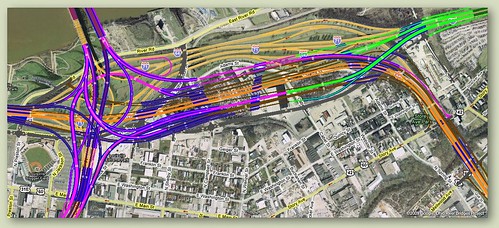
Today, however, riverfront across America are being reclaimed as the old heavy industrial era passes, our rivers are cleaned up, and the water becomes valuable for recreational and other purposes. Today, the riverfront in Louisville is a wonder and beautiful area:
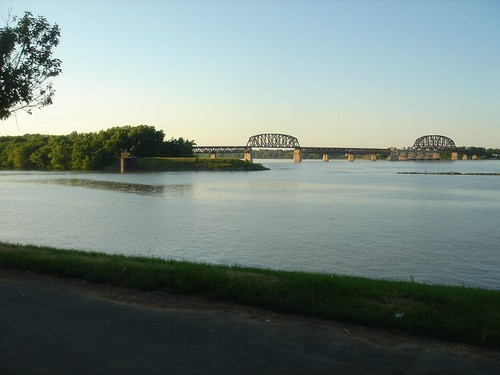

There are so many cities across America with glorified creeks that they are nevertheless trying to reclaim as valuable riverfront parkland. My friends, this is what a real river looks like.
Unfortunately, Louisville has long been cut off from the river. While its downtown is only a stone’s throw from the riverfront, there’s almost no sense that it is there when you are in the city. Downtown and the West End are cut off from the river by a combination of a flood wall and a freeway. The only time most people in Louisville is ever see the river is when they drive across a bridge or visit the Belvedere, a sort of elevated public plaza.
To see why, just check out the photos of what blocks the riverfront today, right now:
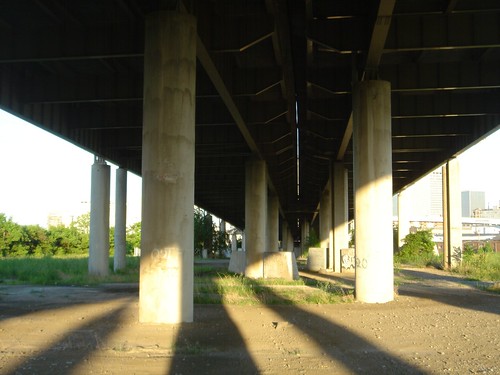

Here’s another one showing the 9th St. ramp system:
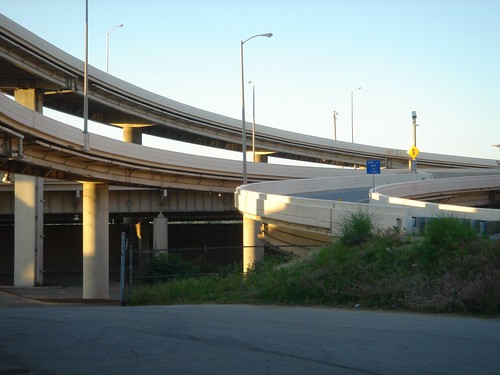
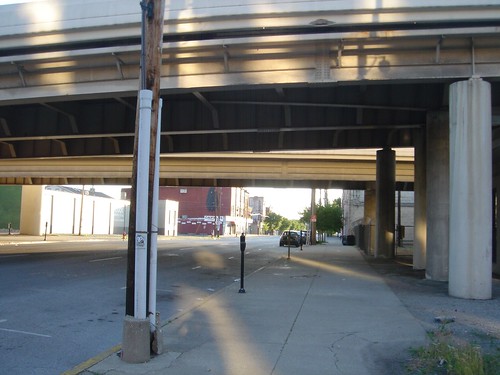
It’s not just I-64. The expansion of Spaghetti means the widening of the I-65 approach through the hospital curve. Our friends at Broken Sidewalk put together fabulous coverage of this. Here’s a rendering they pulled from the bridges project materials:

To put in in perspective, here’s the current I-65 with the footprint of the new overlaid on it:

But wait, as it turns out, the estate isn’t actually impacted by the path of the road at all:

8664 has a better idea. Instead of all this destruction, Louisville can:
- Build the East End bridge as planned. (As an addition, I’d suggest ditching the tunnel).
- Tear down I-64 from just east of 22nd St. to the Kennedy Bridge, replacing it with an at grade parkway.
- Simplify Spaghetti Junction to remove un-needed ramps and reduce congestion.
- Re-route I-64 over I-265 across the new East End bridge. Rename the current I-64 in the interior of that bypass as I-364.
This plan:
- Saves a huge amount of money by eliminating a second bridge and extensive Spaghetti Junction reconstruction.
- Avoids huge urban destruction in the area of Spaghetti Junction
- Enables the city to exploit the riverfront as a recreational area, and reconnect downtown to the riverfront and West End.
The choice is very clear. Does Louisville want this:
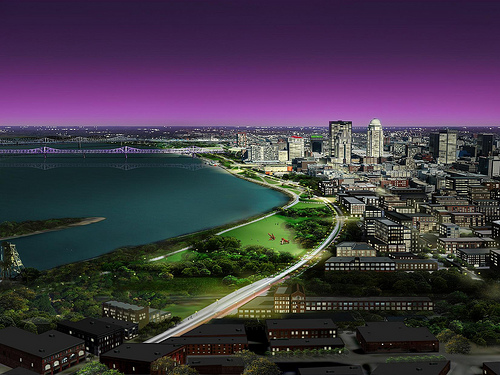
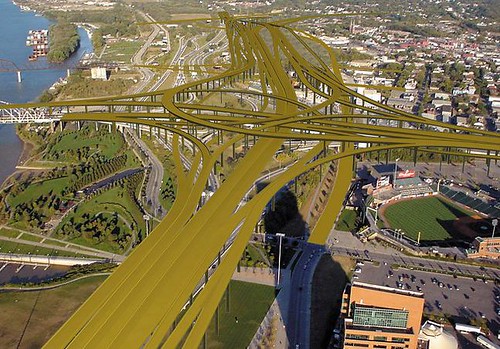
The rendering above does show one quibble I have with 8664. Notice the lack of a floodwall. Even if I-64 were removed, the floodwall will still cut off the city from the river. There are creative ways for landscape architects to deal with flood plains, but I haven’t seen any details on how 8664 would solve it. Clearly, investment would be needed to do major alterations or reconstructions on the floodwall, and it may never be the case that people will walk out of their house and be directly to the riverfront as this makes it appear. I’m convinced this is a solvealbe problem, however.
The pictures below show the huge opportunity that awaits. There are literally hundreds of acres of land on the landward side of I-64 that are a wasteland today, but could be reclaimed for park space. Check this out:

There’s plenty of land if you look the other direction too:
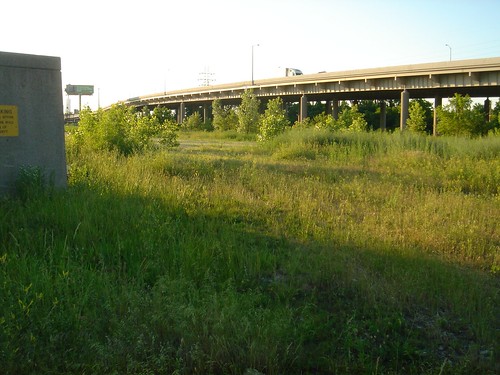
And here’s a last look at I-64 cutting off downtown from the river.
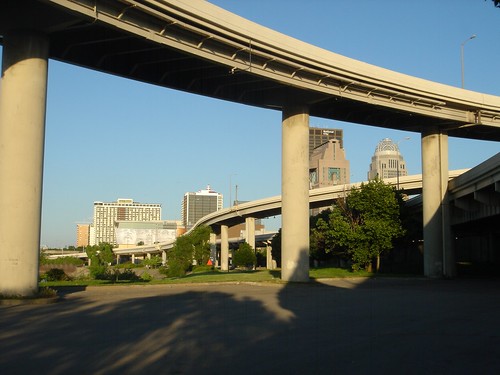
Better and cheaper. What’s not to love?
Of course, not everybody likes better and cheaper. Highway construction and engineering companies sure don’t. And they carry a lot of political weight. But Indiana Gov. Mitch Daniels was already wealthy before taking office, doesn’t need anyone’s money, and isn’t angling to do anything but serve out his last term as governor and continue pushing for change. He’s brought a keen fiscal eye to the Hoosier State, and 8664 would save Hoosiers a bundle by not having to pay for 50% of a downtown bridge plus 100% of the approach work on the Indiana side. His Major Moves highway program is $1 billion underfunded, not even counting this project. This is a great place to start looking for savings. And 8664 preserves the East End bridge that Indiana cares about and which is a no-brainer.
Gov. Steve Beshear took office at a tough time in the Commonwealth, and I think he’s brought some needed seriousness to the role. He strikes me as the kind of guy who is willing to listen to common sense, particularly when Kentucky has huge budget problems, is already having to cancel projects because of highway funding shortfalls, and which has already mortgaged part of its future with GARVEE bonds to pay for the work it is already doing.
Tolls could bail this thing out, but better than toll money is no money. Just because you’re taking it out of motorist pockets at the toll both instead of the gas pump doesn’t mean it is any less a tax and government expense to build this thing. And 8664 is fully compatible with a toll-funded solution.
The East Enders will never give up in their fight to kill the East End bridge, so obviously nothing will convince them. Anything that makes the project less expensive and thus more likely happen they won’t like.
And of course the Courier-Journal, whose editorial page is effectively the PR arm of the Abramson administration, will never stop beating the anti-8664 drum.
But the majority of the public is not in the construction business or a wealthy resident of Prospect. Polls have shown that the public overwhelmingly supports 8664. It is an idea whose time has come. The choice is clear: more of the same or a bold choice for Louisville’s future. 8664 is certainly not risk free, but it’s a bet I believe is well worth taking.
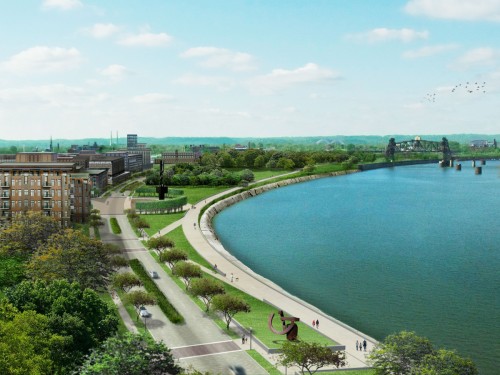
Too bad Abramson is now Gov Beshear’s running mate for the upcoming election. Politics means Beshear can’t support the East End Bridge (even of he wanted to, which I’m not inclined to think he would) since Abramson is so adamantly against it and they don’t want to lose valuable income and support for their gubernatorial election. The highway department also has a lot of sway in Kentucky politics, and that no doubt has played a substantial role in Frankfort being in support of the tolling (ORBP) option.
Aaron, from the topics of [im]proper branding/tourism marketing to projects like this, your posts lately all seem to revolve around the influence of Public Choice Theory and its negative influence on a city’s infrastructure and psyche. Are politicians with marginal integrity the impasse keeping all of us being able to enjoy better cities?
love the 3d animation of driving(flying?)along the proposed route, especially with some great driving tunes. Hope this all comes to pass.
It really looks like this has part of it’s roots in the same issue Pittsburgh now has.
Are there a bunch of stadiums by the waterfront and if so doesn’t this overload of single use attractions bringing tons of motorists in from the suburbs the reason the highways now can’t be torn down?
Is that the whole reason for the city and if so, how can it possibly ever pay for itself?
When I lived on The North Side, I loved walking past all the event parking for people who don’t live in the city. I moved.
Built in to the whole thing is the idea that if that no normal person would want to be in Pittsburgh or would ever live here.
This is the situation in so many cities. The owners of these teams need parking above anything and everything else.
Thanks for the comments.
Everett, that’s an interesting observation. I don’t come at this from a background in public choice theory. I’m probably closer to org theory. Actually, I’m more of a frameworks/practitioner guy than a theoretician, despite what my blog might suggest.
I spend much of my career trying to answer the question of how to make change happen inside of large, complex organizations. I did this both as a consultant and as a staff person. I can say that the challenge is often daunting in the best of cases. It is infinitely harder as a staff person than as a consultant, I can tell you that.
I believe that a huge chunk of the problems we face in both the private and public sector result from organizational dynamics. Perhaps that does color my thinking on these issues. The political is one part of this, but only one.
But why are these organizatons so huge and complex and every day trying to make themselves more so?
In the real marketplace, there’s always a pushback from your customers, employees, investors that doesn’t happen in the Public sector. This isn’t new info, and it’s the basic concept behind our original political system.
So what is ultimately going to happen? Does this much better alternative stand a chance, and if so, when might we find out?
I think the flooding issue obviously has to be solved, but there are creative, urban ways of solving that without cutting the city off from the river. Lets hope Louisville gets this right.
The funny thing (and once again, just like Pittsburgh) is that what should be the town’s highest single priority–flood control isn’t a significant part of this project.
That’s the way it is here where it’s just accepted that the Point, “The Bath Tub” and on occasion even parts of the North Shore will flood or face major storm drain backups.
This tells us that in spite of cosmetic changes, central urban districts are just not valued. Take, the basic amenity of buried power and telephone lines, something Wall Street got after the blizzard of 1888, I think. You figure, this is a useful thing, every business and resident would value and spur high density development. But, how many downtowns in America don’t even have buried power lines or suffer from flood risks like this?
Likely what is at work here is that money is available for highway construction and not for flood control.
Anyway, the overload of stadiums and arenas planned or in existence creates peak load issues which then validate the giant highway. Insane and totally stupid. Can’t one just work towards the street level blvd, implement a nice park and handle the flood issues while letting development take care of itself gradually?
I hate to quibble with anything in this excellent report, but as a long-time resident, here’s how I would describe the Courier-Journal editorial board.
This board is a PR and propaganda catapulting arm of the faux-preservation group River Fields. The head of this board, Keith Runyon, is the husband of Meme Sweets Runyon, the Executive Director of River Fields.
I would describe Abramson as their lackey and as long as he does their bidding, the board acts as his protectorate. Time after time, in scandal after scandal, they have generally maintained a hands-off approach when deep investigative reporting would have been obviously called for.
And in this mayoral election, they have found a new lackey in Greg Fischer.
At one point during the election cycle, when Fischer strayed away from the board’s message on the bridges, they excoriated him, and he promptly performed an Olympics-worthy flip-flop.
Both Abramson and Fischer have drawn financially from the same crowd that makes up River Fields.
Please read my two part series at Louisville History & Issues about the C-J’s endorsement of Greg Fischer (and follow its links for further reading). No matter where you stand on the bridges project and the Louisville mayor’s race, it’s a worthwhile exploration.
Link (Part 1): http://www.historyandissues.org/louisville/viewtopic.php?t=2095 (a link to Part 2 is in a reply)
This reminds me a of a proposal from a few years ago called the Plan of Nashville, put together by the Nashville Civic Design Center. Three interstates intersect and encircle downtown Nashville very closely and the Plan proposes their removal and transformation into urban boulevards (http://www.civicdesigncenter.org/plan_of_nashville/table_of_contents, under “Getting Around”). There already exist bypasses around the Nashville (as with Louisville, or plans for them from what I gather) and around 80% of all traffic that goes through the downtown interstate loop are merely passing through, anyway. More roads are obviously not the answer. The renderings of the Ohio River Bridges Project look ridiculous. It’s as if Louisville is being overrun by a horde of Robert Moses zombies…
Nobody has answered my question about the overload of existing or proposed stadiums. You dump them in a line like that and any day more than one or two are full, you are going to have peak traffic tie ups. The rest of the time–it’s likely to be empty. From what I can tell, all this will add to peak downtown commuter traffic.
In fact what you have here is an anti urban land use taking up most of the land in a critical area of town.
Ask yourself this question. What will be the prime priority of team owners and stadium operators if not to have maximum parking and easy in and out highway access? For them it might be better if nobody lived close by. Do they want some mom in a stroller crossing the street to the park? Really?
It’s one thing to have, a bunch of small venues sprinkled around. If you spread them out even a little and mixed them into the city, there would be no problem.
What’s happening here brings up a deep issue of self esteem and self respect. Louisville, like Pittsburgh seems obsessed with having people from it’s suburbs come into town even if they have to tear the whole town down to do it. Meanwhile they show nothing but disrespect for those who were dumb enough to stay in town or actually invest there.
John, it is simply too costly to design for peak of the peak capacity. Almost no one ever does that. That’s why you don’t size your dining room table for the handful of times you’ve got extra people in the house at Thanksgiving and Christmas. The world won’t come to an end of there’s point congestion during extremely limited periods – and congestion pricing could easily smooth that demand spike.
Ooops, the Mom isn’t in the stroller. Also, I assumed the Ali Center was a sports stadium of some kind. Even so, it really looks like you have an area far too focused on “tourist” attractions. Look at Pittsburgh’s North Shore, the area with the greatest single mass of mega amenities and tourist attractions. Is it really very successful?
Where do most people go to hang out–The South Side, Shadyside, Bloomfield or Lawrenceville. Basically, the casino is now required to help pay for the tax whole created by the stadiums and in spite of it’s great location and wonderful surviving housing stock, the neighborhoods of The North Side are troubled. It’s now a parking lot posing as something else.
Even in Baltimore, the so called model for this sort of thing, the news is pretty shaky and Baltimore is positioned in a far denser metro region. If tourism only doesn’t pay the bills there, Louisville doesn’t stand a chance. As far as I know, the news from San Fransisco’s new mega museum arts district is also underwhelming.
Once again, Jane Jacobs was right.
“It is simply too costly to design for peak of the peak capacity. Almost no one ever does that. That’s why you don’t size your dining room table for the handful of times you’ve got extra people in the house at Thanksgiving and Christmas. The world won’t come to an end of there’s point congestion during extremely limited periods — and congestion pricing could easily smooth that demand spike.”
Well, I haven’t studied it but the Robert Moses horror looks like a plan built for peak capacity. Pittsburgh’s subsidised city parking policies are ceratainly built on that idea. Half of the North shore is now parking garages, and the Downtown has huge parking capacity along with all the surface lots in the Strip and around Mellon Arena.
The logic is that you need all this and perhaps more highways cause if there are any events downtown like a gallery crawl or a fundraiser and there’s a Steeler, Pirate or Pens game there’s a problem with traffic and parking.
All of the tourism photos show the exiting place the city is when all these events are going on. But, the people who know the town well know it’s pretty empty the rest of the time.
Congestion pricing? Are you serious? I really doubt that’s on the table or being considered.
@John Morris, congestion pricing and public transit are both viable options that should be considered as they alleviate car traffic. Whether Pittsburgh or Louisville is including them in is doubtful, but ultimately up to its citizens, like you.
Aaron, why don’t more projects have beautiful renderings like the one above? I think it’d be easier to garner support, even if financially difficult, when you have great imagery that clearly shows the two options. (Being a graphic designer, I am biased towards the pretty pictures.)
@Everett, I agree completely on the renderings. See:
http://www.urbanophile.com/2009/08/19/chicago-transit-from-good-to-great-part-1-building-the-vision/
@Aaron, I’m sure that just about every city could benefit from a Burnham-type plan.
I was hoping that someone who has actually been involved in an urban project’s development process could shed some light on what drives the decision to have renderings and other graphic marketing materials made.
I’m sorry that I actually don’t know that much about the Burnham plan and particularly how it was implemented.
Were there massive private sector unions at that time distorting the process? Was eminent domain, used on anything like the scale it is so commonly and easily used today? Why do need to convince people of anything except that you have a gun? Is the result of a process like that likely to be good?
My guess at the base of it was that the Burnham plan was generally rational and well sold because that was the only way it was going to get done. Major actors in the community, particularly, the business and real estate community bought in.
These days, with state DOTs, established funding priorities which default towards cars and a goon on the right congressional committee is what drives stuff. Not surprisingly, the results are more about a ribbon cutting and short term job gains than anything else.
The good news is that this “system”, that puts politics and power over economic reason is careening towards bankruptcy, leaving the field potentially open to real private enterprise. This means reconnecting all the dots between land use, development and transit again.
John Morris – you must not be a sports fan. Louisville has no NBA, NFL or MLB team. There is an arena (being named the KFC YUM Center, God help us all…)going up next to the Ohio River and the 2nd Street bridge to S Indiana (Clark Memorial bridge – not an interstate bridge). It’s not like Cincy with all the arenas & sports stadiums. The Ali Center is a museum mostly about Muhammad Ali. With out I-64, Louisville’s waterfront could be extended West of downtown into the historic yet crumbling Portland areas spurring more growth in original urban areas and perhaps even be a way to finally revitalize the old Marine Hospital – a very endangered historic building which was a hospital not for the US Marines but for old river mariners. Louisville’s river roots could really run deep.
And thanks to this awesome blog and author who knows what a REAL RIVER looks like. What would Memphis or NO be without the Mighty Mississippi? Louisville is a city with heart but Steve’s analysis of the deep pockets of both outgoing and incoming Mayors is sadly true and frightening.
Yes, I jumped to the conclusion that the Ali Center was some kind of arena but if you look you see I apologised for that.
Also, I’ll admit to projecting a bit from the problems IMHO, the poorly located stadiums have done in Pittsburgh. All that non taxable land and the need for parking has done a lot of damage. Mostly when I’m at PNC, admiring the view, I think about what a great location this is and how much I might have loved living there.
Even so venues need to be properly thought out in terms of transit options and except in the case of a few major cities with great transit like NYC, usually cause a lot of trouble. The bigger the arena, the greater the likehood it will be empty most of the time. Add to this the parking requirement and you are not exactly likey to have a a net plus at least to the people who live or work near it.
Compare this to say a bunch of scattered movie theaters,(boy those were the best pound for pound attractions there were) playhouses, or music clubs. The peak load issue is much less. In effect, big arena’s are very dangerous and concentrated bets. Suppose, your team sucks? Suppose you have a Ben or Michael Vick situation that just turns your fan base off. It’s a big problem. This isn’t the case with a music club where one bad act doesn’t wreck the place.
Isn’t the river itself along with walking distance to downtown enough of an attraction along with a park and perhaps one or two of these venues? If one was pushed back just a few blocks, my guess is it would work much better.
Anyway, I can’t help feeling that this line up of venues helped provide the reasoning behind the DOT plan.
My favorite sport is in fact college basketball.
The 8664 concept reminds me a bit of Lake Shore Drive in Grant Park. A limited access highway turns into a surface road through a cityfront park and then back to limited access again.
The sad thing with the second I-65 bridge is that it will take out some of that new riverfront park.